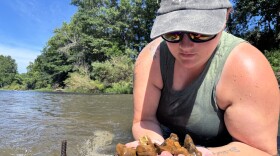
Celia Llopis-Jepsen
Reporter, Kansas News ServiceI'm the creator and host of the environmental podcast Up From Dust. I write about how the world is transforming around us, from topsoil loss and invasive species to climate change. My goal is to explain why these stories matter to Kansas, and to report on the farmers, ranchers, scientists and other engaged people working to make Kansas more resilient.
Before joining the Kansas News Service, I covered education and the Statehouse for the Topeka Capital-Journal.
I have a master's in journalism from Columbia University and a master’s in bilingualism studies from Stockholm University in Sweden. Before coming to Kansas, I spent a decade living and working in Sweden, Germany and Taiwan, including several cherished years working for the Taipei Times.
Email me at celia@kcur.org.
-
In one long-polluted Ozark river, the little fish darting through the water and the rare mussels hiding on the pebbly bottom tell a story worth celebrating. They’re signs that the Spring River is benefitting from environmental cleanups after a century of mining pollution. A professor and his students are uncovering the evidence of recovery. But there’s a twist: They’ve also found a new environmental challenge unfolding farther upstream.
-
The fish and rare mussels hiding in the Spring River that flows through Kansas and Missouri are signs that environmental cleanups are helping river wildlife recover from a century of mining pollution.
-
Deep Fission says it plans to install a nuclear reactor underground at an industrial park in southeast Kansas. State and local government leaders are on board. It’s part of a national push for new nuclear energy generation.
-
Animals that disappeared from some rivers because of pollution, dams and overharvesting are getting a new lease on life that could have ripple effects for other wildlife and for humans.
-
Trevor Starks is on a mission. He wants to help the humble but powerful creatures that clean the waters of the Neosho River: freshwater mussels. For decades, their populations dwindled due to overharvesting, pollution and dam construction. To right the wrongs of the past, Trevor and his colleagues are releasing rare mussels by the hundreds. Now, the only thing left is to find out if it worked.
-
Two companies are pursuing two very different visions for building and operating nuclear reactors in Kansas.
-
Deep Fission is a fledgling startup that says it can help tech companies meet the "explosive demand" for more energy to power artificial intelligence. It's one of two nuclear companies that have announced plans related to Kansas in the past month.
-
The Midwest has a reputation for vast fields of corn and soybeans that stretch to the horizon. But on some farms, strips of wildflowers and little bluestem now interrupt the crops, tiny glimpses of the prairie that once dominated the region. They’re an effort to hold back the fertilizer runoff that pollutes drinking water and then travels hundreds of miles downstream, where it fuels the Gulf of Mexico’s infamous Dead Zone.
-
A company cofounded by Bill Gates will explore building a reactor in Kansas. It would generate power without emissions, but environmental groups have concerns.
-
In dry years, Tuttle Creek Lake and other reservoirs keep the Kansas River flowing strong enough to provide drinking water for hundreds of thousands of people. But these manmade lakes are disappearing.







